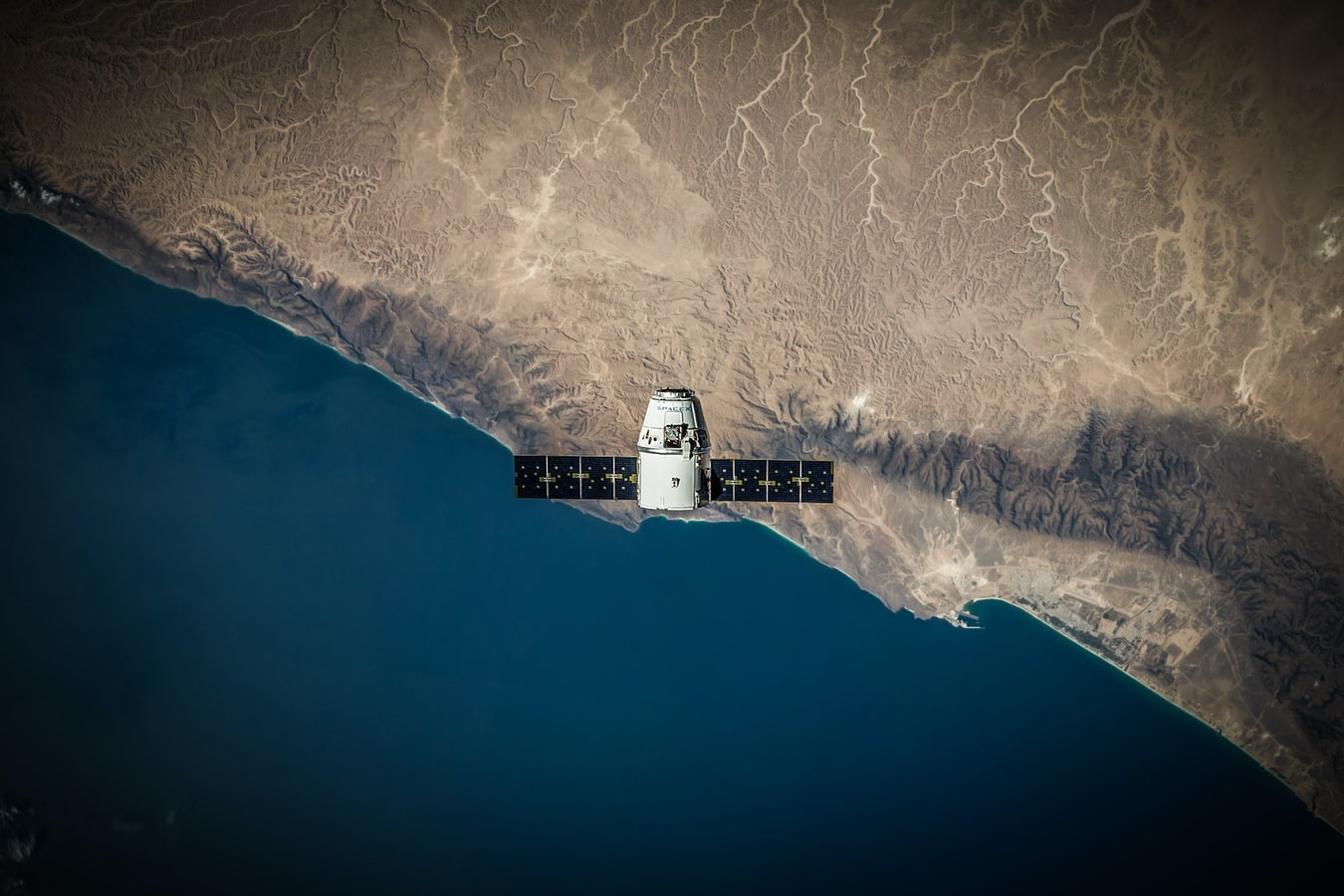Since the beginning of the 2010’s, telecommunication satellites are navigating troubled waters between a predicted decline, and the promise of technological breakthroughs.
Geostationary satellites (GEO) were for a time supposedly bound to a fatal decline, due to their limited capacities and uncertain business models, in a context where terrestrial systems were supposed to ensure a complete coverage of the population. However, new ambitious GEO projects are now being led, financed, and launched, from American operator Viasat (Viasat-3) to its European counterpart Eutelsat (Konnect & Konnect-VHTS).
At the same time, tech majors announced and/or launched major projects with the promise of a disruptive technology, by developing low orbit constellations: Softbank (OneWeb), Amazon (Kuiper), SpaceX (Starlink), etc. These new systems should, according to their supporters, revolutionize satellite systems and their uses, and provide the segment with incredible opportunities.
Despite these exciting developments, the recent Chapter 11 filings of LEO constellations pioneer OneWeb and world’s second largest satcom operator Intelsat have thrown doubt on the solidity of the satcom industry, and question its perspectives. Between a predicted decline, technological hopes and financial troubles, what future for telecommunications satellites?
GEO satellites are at last finding their place in the technology mix
GEO satellites, which were strongly criticized in Europe after some difficulties encountered with the previous generations, seem to finally position themselves as an essential component for the coverage of rural and isolated populations with very high speed broadband (>30Mbps).
This situation stems from the acknowledgement, now shared by an increasing number of decisionmakers, that a technology mix will be necessary. The dream of a « gigabit society » where 100% of European populations have access to very high speed broadband through terrestrial technologies (fibre, 4G/5G) is increasingly clashing with the economic and technical reality. Indeed, rolling out fibre to distant, difficult to access locations cannot be profitable, and would only be done through substantial public subsidies which can amount to several thousand euros per user. A 100% fibre roll-out, as considered by countries such as France, is therefore financially costly and technically complex, and could end up limited. Mobile technologies (4G/5G) as complements to fibre coverage are also unlikely to provide a full coverage, due to similar technical and financial constraints. Decisionmakers are now increasingly turning to satellites to ensure the coverage of the “last percent” of the population with very high speed internet, because it is the only technology capable of doing so at a reasonable cost.
At the same time, new and ambitious GEO projects are emerging, and bring quality technical solutions to be the ideal complement to terrestrial technologies in the near-to-mid future. New generation satellites called “VHTS” (Very High Throughput Systems) offer much higher capacity: 500 Gbps for Eutelsat’s Konnec-VHTS, compared to 70 Gbps in the currently used KA-SAT. This improvement will allow very high speed connectivity to millions of European users today.
These new GEO systems come with improved, more competitive industrial and business models which could overcome an historical weakness of satcoms: the cost of user equipment (antenna, box). The price of this equipment could indeed be divided by 2 compared to the previous generation, which would greatly facilitate the adoption of satellite connectivity. The perspective of renewed competition between Viasat and Eutelsat adds to this industrial progress and demonstrates the perceived potential of the market.
However, the inherent limits of the GEO technology remain, and will be an impediment to their long-term growth. Indeed, latency is a physical constraint related to the earth-satellite distance, and cannot be reduced. The capacity of in-service satellites, fixed by nature, will also not be able to evolve and adapt to changing customer behaviors and to a quickly growing data consumption.
The GEO satellite thus seems to have found its proper place in the technology mix, as a complement to terrestrial technologies to ensure the coverage of isolated areas with very high speed broadband over a 5 to 10 years horizon. Beyond this horizon, significant technological progress will have to be made for GEO systems to keep answering the growing demand for data, and maintain their position in competition with new, emerging technologies.
Technology evolutions and new uses might multiply the potential of satcoms in the long term
Low-earth orbit (LEO) constellations represent a breakthrough technological and industrial innovation for satcoms. From a unique geostationary satellite covering a fixed portion of the globa, LEOs offer a set of series-produced satellites covering the entire globe and offering evolutive capacities (as operators can add or replace satellites within the constellation), and almost eliminating latency (LEOs being much closer to Earth). Technically, operators such as OneWeb and O3B promise “fibre from the sky”: performances close to a full-fibre connection.
Quantum satellites are being developed and have the potential to offer completely secure communications, which is currently impossible through fibre networks. This is crucial for the most critical crypted information whether military and governmental, financial, or sanitary.
The advent of 5G standards makes it possible to develop new satellite technology which can provide high-speed mobile connectivity by satellite over the entire globe, via standard terminals (smartphones).This could lead in the long run to a full 4G/5G coverage over the entire world, without gaps.
All these technologies are however not mature, and their business models are not proven. LEO systems will at first be reserved for B2B and B2G uses due to the very high cost of user equipment ($10,000 to $1 million). The CAPEX intensity of such projects, which require billions of dollars of initial investment, make their business models very fragile as demonstrated by the recent Chapter 11 filing of LEO pioneer OneWeb. These constellations will have to rely heavily on significant government contracts (SpaceX) – sometimes close to subsidies, or on an important existing B2B customer base (Amazon), and should not have B2C applications in Europe for the next 5 to 10 years.
Nonetheless, these new satellite technologies will be able to rely on the rapid development of connected uses to both find and strengthen their business models, and increase their market potential.
Data consumption from end users is growing at a considerable pace: in France, total mobile data consumption has increased 16-fold from 2015 to 2020. New satellite technologies and especially the evolutive capacity offered by LEOs will therefore be central to efficiently answer a fast-growing demand.
The development of new connected uses, in relation to 5G developments, could also require satellite connectivity in order to ensure continuity of service. It could especially be the case for connected health, which will have to made available in rural and distant areas as much as in urban areas, or for connected vehicles for which continuity of service can be critical. For all of these new uses, satellites can provide a relevant solution by playing various crucial roles: direct connectivity to end users, backhaul, redundancy solution for critical applications, etc.
Satellites do have a future in telecommunications. In the short to medium term, traditional GEO models are finding their right place in the technology mix and will serve as complements to terrestrial technologies.
In the medium-to-long term, however, the future of satcoms will rely on new technical and industrial systems. Their business models are starting to emerge and must be developed and strengthened concurrently with the development of new uses. In the face of these new developments and of strengthening competition from tech giants, historical players find themselves at a critical juncture: they now have to successfully position themselves on the right technologies for the right uses, with the right business models and by creating the right business environment. In order to bear the heavy investments required by new systems (LEO, 5G, …) and to compete with deep-pocketed tech giants often backed by governments, a convergence between actors could be envisaged which could go so far as to mergers and market consolidation.
Raphaël Koenig & Chrystelle Briantais


PMP is a strategy, development and transformation consulting firm servicing executives and covering all the fields of expertise of strategy consulting in various industries.
PMP has developed strong and recognized expertise beyond the traditional scope of strategy consulting.
Our teams support players in the telecom, media and technology industries in the definition of their strategies in a market shaken by digital pure players.
Published on the following french medias:






